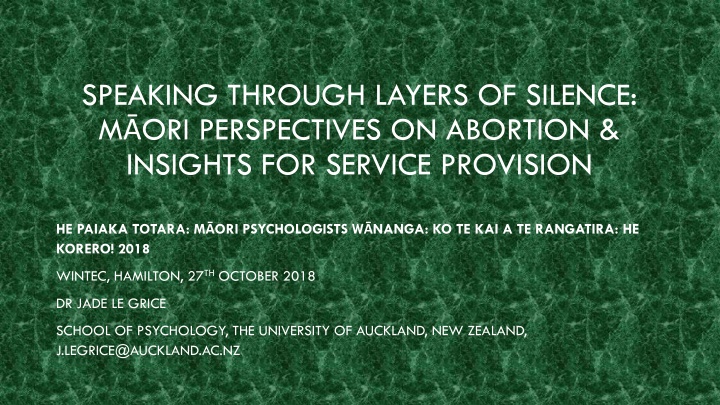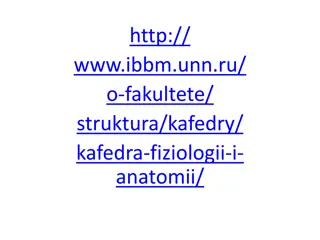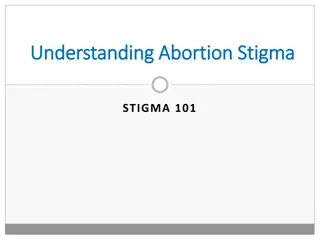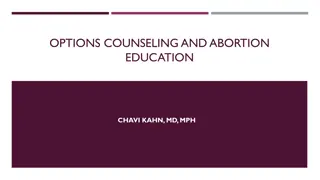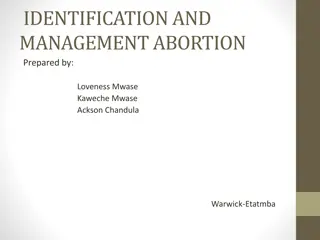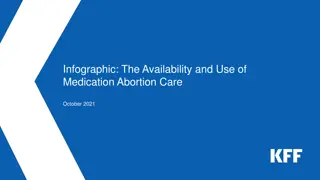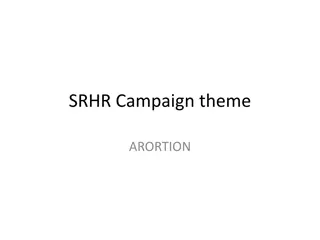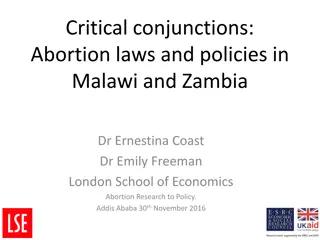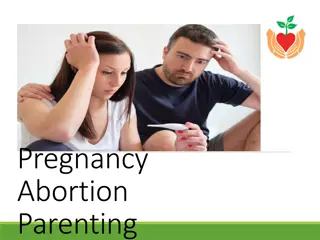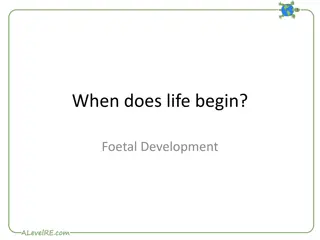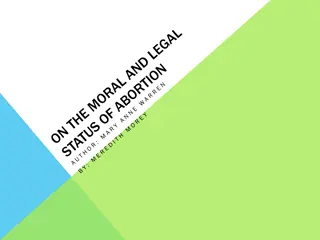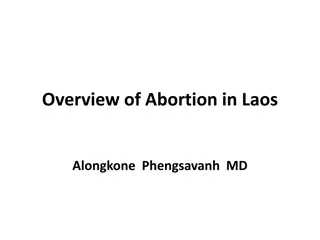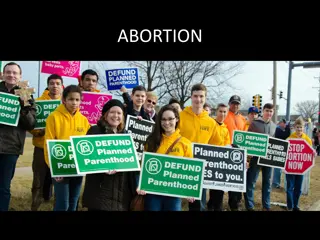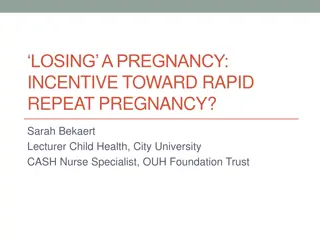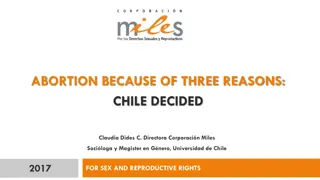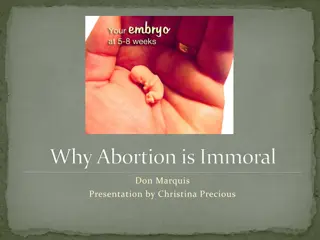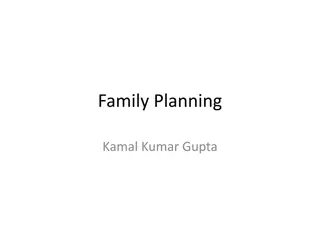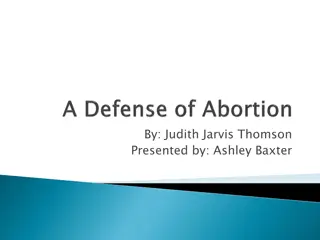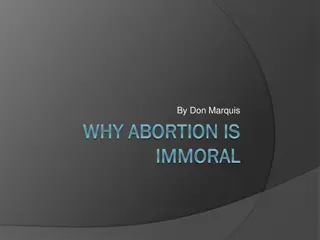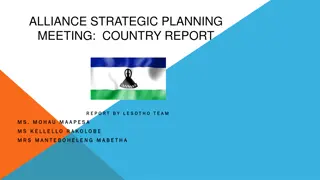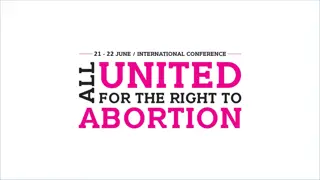Mori Perspectives on Abortion: Insights and Challenges
Exploring Mori perspectives on abortion reveals a nuanced narrative that challenges dominant representations. Historical accounts and misrepresentations shed light on a complex reality. The need to attend to Mori reproductive rights in under-researched areas is emphasized, highlighting contemporary perspectives that bridge traditional practices with modern challenges.
Download Presentation

Please find below an Image/Link to download the presentation.
The content on the website is provided AS IS for your information and personal use only. It may not be sold, licensed, or shared on other websites without obtaining consent from the author.If you encounter any issues during the download, it is possible that the publisher has removed the file from their server.
You are allowed to download the files provided on this website for personal or commercial use, subject to the condition that they are used lawfully. All files are the property of their respective owners.
The content on the website is provided AS IS for your information and personal use only. It may not be sold, licensed, or shared on other websites without obtaining consent from the author.
E N D
Presentation Transcript
SPEAKING THROUGH LAYERS OF SILENCE: M ORI PERSPECTIVES ON ABORTION & INSIGHTS FOR SERVICE PROVISION HE PAIAKA TOTARA: M ORI PSYCHOLOGISTS W NANGA: KO TE KAI A TE RANGATIRA: HE KORERO! 2018 WINTEC, HAMILTON, 27THOCTOBER 2018 DR JADE LE GRICE SCHOOL OF PSYCHOLOGY, THE UNIVERSITY OF AUCKLAND, NEW ZEALAND, J.LEGRICE@AUCKLAND.AC.NZ
Narratives of resistance to colonial silencing: Whakapapa Ngahuia Harris - my great, great, great, great grandmother Rihi (Lizzie) Hancy - my great, great, great grandmother Hone Toia (man pictured standing in top hat) my great great grandfather
CAVEATS DURING DISCUSSION, PLEASE BE RESPECTFUL OF WOMEN IN THE ROOM WHO HAVE HAD AN ABORTION, AND PEOPLE WHO HAVE SUPPORTED SOMEONE WITH AN ABORTION IF CONVERSATION IS DIFFICULT PLEASE DON T FEEL OBLIGATED TO STAY
THANK YOU TO TAKAWAI JACOBS, PIO JACOBS, NGAHUIA JACOBS AUCKLAND MEDICAL AID TRUST VIRGINIA BRAUN, MARGARET WETHERELL ALISON GREEN
MORI PERSPECTIVES ON ABORTION Dominant representations of traditional M ori patterns of practice associated with reproduction indicate disapproval of abortion (Turia, 2007; Rimene, Hassan, & Broughton, 1998; Manihera & Turnbull, 1990). Yet, historical accounts of M ori practices of abortion tell a more complex story. Abortion was not linguistically distinguished from miscarriage (T. Smith, 2012). Known and accepted methods for causing a loss of conception (Palmer, 2002; T. Smith, 2012; Tangohau, 2003).
MIS-REPRESENTATION OF MORI PERSPECTIVES ON ABORTION Existing research about M ori engagement with abortion, written by P keh men. Constituted within colonising, oppressive notions about M ori that are tied to notions of M ori savagery. Assumed patriarchal gender relations, and negative and vengeful subject positions for women (e.g. Hunton, 1977). Suggested abortion was widely practiced among M ori due to savagery (e.g. Hunton, 1977) . Suggested abortion was not practiced due to superstition (e.g. Gluckman, 1973, 1981). Narratives aligned with wider national narratives of missionaries saving M ori through British colonisation and assumption of rule (Pool, 2015) and interpretations of M ori cultural deficits
ATTENDING TO MORI REPRODUCTIVE RIGHTS IN AN UNDER-RESEARCHED AREA: WHAT ARE CONTEMPORARY M ORI PERSPECTIVES ON ABORTION?
RESEARCH METHODOLOGY Mana W hine research (Irwin, 1992; Le Grice, 2014; Pihama, 2001; Simmonds, 2009, 2011). Decolonising historical and contemporary colonial interpretations about M ori Legitimating m tauranga M ori (M ori knowledges) Acknowledging diverse realities in a multicultural, global context. Recursive process Literature review Interviewing 43 participants (15 men, 16 women, 12 key informants) Critical realist, M ori social constructionist, thematic analysis of data
MORI PERSPECTIVES ON ABORTION THREE THEMES 1. PROTECTION OF NEW LIFE 2. WH NAU INVESTMENT & SUPPORT 3. WOMEN S INDIVIDUAL CHOICE DRAWN FROM: LE GRICE, J. & BRAUN, V. (2017). INDIGENOUS (M ORI) PERSPECTIVES ON ABORTION IN NEW ZEALAND, FEMINISM & PSYCHOLOGY 27(2).
1. PROTECTION OF NEW LIFE 2. WH NAU INVESTMENT & SUPPORT 3. WOMEN S INDIVIDUAL CHOICE I d just say look, have it and go and adopt it, if you want to adopt it. At least you know it s, it s being born into the world. Yeah, you know? But yeah, but not that [draws in a sharp breath] Yep. [Extract 1, Maori elder, woman, 50s, rural]
1. PROTECTION OF NEW LIFE 2. WH NAU INVESTMENT & SUPPORT 3. WOMEN S INDIVIDUAL CHOICE I would be devastated if she, if I didn t know that my daughter um ah was pregnant you know and had aborted her baby. I would have been devastated . . . I feel for my daughter to be so so alone to have to make a decision like that . . . I find that um there s a strong need I don t know what it is and I don t know, for a [M ori elder] element within that, ah an elders support group who were there for children, who were there for these young kids. [Extract 7, man, 40s, rural]
1. PROTECTION OF NEW LIFE 2. WH NAU INVESTMENT & SUPPORT 3. WOMEN S INDIVIDUAL CHOICE I remember the counsellor at the, at the [abortion] clinic . . . She made sure that I was sure about it. So that s when I I like really explained to her, you know, that . . . this is the last thing that I wanted to happen but that I actually just couldn t I couldn t bear another child any more like, you know? I just talked to her about my relationship with my partner . . . I had to be blunt and let her know that you know we don t have the best family, well we didn t create the best family environment to have a family in . . . we had a um (2.0) a mind game kind of relationship where, emotional abusive relationship kind of thing . . . Like it got really bad it escalated and escalated to a point where like (1.0) fists were flying and H ria was scared and um (2.0) you know cars were being crashed and shit like that. It just got really, really bad. [Extract 5, woman, 20s, urban]
ADVOCATING CULTURALLY RESPONSIVE PRACTICE LEGITIMATING M TAURANGA M ORI (M ORI KNOWLEDGES) IN ABORTION SERVICES 1. KAI ATAWHAI 2. MANAAKITANGA
KAI ATAWHAI I think one of the biggest practice and traditions is about M ori women taking the whenua (abortive tissue) home and I think that s a huge thing . . .Um you know abortion s still a very secretive um issue, you know? Some wh nau . . . you know, I haven t told my mother yet you know but . . . I ll be taking it home because my mother will be burying it . So . . . the parents may not agree with um, you know, the actual abortion but there s still some of that traditional . . . [practice of] whenua (abortive tissue) to whenua (land). [Extract 9, clinician, 50s, urban]
KAI ATAWHAI Written by Jade Le Grice & Takawai Jacobs for the Abortion Supervisory Committee Guidelines for Practice (2018) The practice of whenua ki te whenua (returning pregnancy tissue/placenta to ancestral lands) is significant to reproductive health. This practice nurtures connections between atua, tangata and whenua, providing kai atawhai (sheltering and protection) in these domains. Kai atawhai can occur through respect and acknowledgement of the developing tissue, as part of the woman, when this is returned to whenua (land) significant to the lives of ancestors and future descendants.
MANAAKITANGA Written by Jade Le Grice for the Abortion Supervisory Committee Guidelines for Practice (2018) Abortion Services have a responsibility to manaaki (show respect for, support, care, protect) those who decide to engage with them. Good provision of manaakitanga (the process of showing generosity, support and care for others) works to enhance a person/people s mana (inherent dignity), retains the safety and health of their interconnected mauri (life force), and mobilises their tino rangatiratanga (ability to make their own informed choices).
1. HOW MIGHT WE BRING MANAAKITANGA INTO ABORTION SERVICES? 2. WOMEN CAN BE IN DISTRESSING CIRCUMSTANCES WHEN THEY SEEK AN ABORTION. HOW CAN CLINICIANS PROVIDE MANAAKITANGA TO WOMEN WHO ARE ANGRY, HIGH, AND/OR RESISTANT TO THEIR SUPPORT? 3. WHAT FURTHER M TAURANGA M ORI COULD SUPPORT WOMEN WHO ARE CONTEMPLATING, OR HAVE HAD, AN ABORTION?
MANAAKITANGA & WELLBEING/HEALTH Written by Jade Le Grice for the Abortion Supervisory Committee Guidelines for Practice (2018) Hinengaro - mental wellbeing the degree to which space has been made available to the person to feel safe to open up, how she makes sense of these experiences, how this may be mediated by the cultural and social environment, norms, assumptions, routine practices (eg. foyer d cor, conversations, physical procedures, visible ultrasound). Tinana - physical wellbeing the degree to which the person s behaviour and non- verbal communication has been attended to, to ascertain what they need, how comfortable she feels voicing disquiet or unease, interprets bodily sensations, elicits support, is taken seriously and offered adequate support (e.g. engagement and due regard for safety in physical procedures, pain relief or contraceptive options).
MANAAKITANGA & WELLBEING/HEALTH Written by Jade Le Grice for the Abortion Supervisory Committee Guidelines for Practice (2018) Wairua - spiritual domains of wellbeing the degree to which respect is maintained for her spiritual process, how she makes meaning of this through her senses, and is provided with time, space, and access to practices that ease her wairua (e.g spiritual, aspirational, & religious needs). Wh nau family and community aspects of wellbeing the degree to which potential wh nau challenges are understood, clarity in her decision regarding wh nau involvement, spaces to cater for supportive wh nau, an opportunity to reflect upon broaching conversation with wh nau afterwards, and if appropriate, reflections on future wh nau aspirations (eg. pre & post-abortion conversations & comfortable spaces for wh nau support).
REDRESSING THE SILENCING OF MTAURANGA M ORI IN ABORTION SERVICES The deliberate loss of conception is not anathema to M ori knowledges, ways of being and patterns of practice M ori are diverse in their understanding and engagement with m tauranga M ori, with implications for their perspectives on abortion Christian influences, focus on protecting the new life (although often framed as personal choice) Mana W hine, women s self determination in the context of her unique circumstances, hopes, dreams and aspirations Focus and prioritisation of wh nau, and care for one another (whangai, and/or support for the individual woman) The provision of culturally resonant care, and the incorporation of m tauranga M ori in health services, is a right promised to us in Te Tiriti o Waitangi Scope for Kai atawhai Importance of manaakitanga
REFERENCE LIST Agadjanian, V. (2002). Is abortion culture fading in the former Soviet Union? Views about abortion and contraception in Kazakhstan. Studies in Family Planning, 33(3), 237 248. Beckman, L. (2017). Abortion in the United States: The continuing controversy. Feminism and Psychology, 27, 101 113. Gluckman, L. K. (1973). M ori attitudes to abortion. The Linacre Quarterly, 40(1), 44 48. Gluckman, L. K. (1981). Abortion in the nineteenth century M ori: A historical and ethnopsychiatric review. New Zealand Medical Journal, 93(685), 384 386. Henshaw, S. K. (1990). Induced abortion: A world review, 1990. Family Planning Perspectives, 22(2), 76 89. Hunton, R. (1977). M ori abortion practices in pre and early European New Zealand. The New Zealand Medical Journal, 86(602), 567 570. Irwin, K. (1992). Towards theories of M ori feminism. In R. D. Plessis (Ed.), Feminist voices: Women s studies texts for Aotearoa/New Zealand. Auckland, New Zealand: Oxford University Press. Le Grice, J. (2014). M ori and reproduction, sexuality education, maternity and abortion. (Doctor of Philosophy), The University of Auckland, Auckland, New Zealand. Le Grice, J. & Braun, V. (2017). Indigenous (M ori) perspectives on abortion in New Zealand, Feminism & Psychology 27(2).
REFERENCE LIST Manihera, C., & Turnbull, T. (1990). Some gynecological issues from a rural M ori perspective. New Zealand Medical Journal, 103, 458 459. Palmer, S. (2002). Hei oranga mo nga wahine hapu (o Hauraki) i roto i te whare ora (Doctor of Philosophy), University of Waikato, Hamilton, New Zealand. Pihama, L. (2001). Tihei Mauri Ora: Honouring our voices: Mana Wahine as a Kaupapa M ori Theoretical Framework (Doctor of Philosophy), The University of Auckland, Auckland, New Zealand. Pool, I. (2015). Colonization and development in New Zealand Between 1769 and 1900: The Seeds of Rangiatea (Vol. 3). Cham, Germany, Switzerland: Springer International. Rimene, C., Hassan, C., & Broughton, J. (1998). Ukaipo: The place of nurturing. M ori women and childbirth. Dunedin, New Zealand: Te Roopu Rangahau Hauora M ori o Ngai Tahu. Simmonds, N. (2009). Mana wahine geographies: Spiritual, spatial and embodied understandings of Papatuanuku (Master of Social Sciences), The University of Waikato, Hamilton, New Zealand. Simmonds, N. (2011). Mana wahine: Decolonising politics. Women s Studies Journal, 25(2), 11 25.T. Smith, 2012 Tangohau, A. (2003). Te Mana a nga W ahine Whare Tangata M aori women in the role of mothering (Master of Arts), Victoria University of Wellington, Wellington, New Zealand. Turia, T. (2007). Notice of motion. Retrieved from http://www.parliament.nz/en- nz/pb/debates/debates/daily/48HansD_20070614/volume-639-week-46-thursday-14-june-2007.
